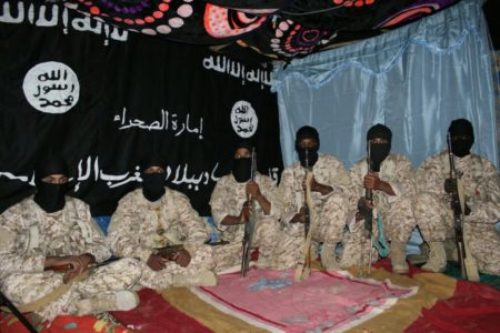
Jihadists belonging to al Qaeda in the Islamic Maghreb’s Sahara Emirate in 2016
While al Qaeda’s other branches around the world receive more attention, like in Syria or Yemen, the global jihadist group has been continuously active throughout West Africa as well. Since January, at least 101 attacks throughout the region have been attributed to al Qaeda, according to data compiled by FDD’s Long War Journal.
Al Qaeda’s main faction in West Africa, Group for the Support of Islam and Muslims (JNIM), was formed earlier this year and is comprised of several Malian-based jihadist groups that were already within al Qaeda’s network. This includes al Qaeda in the Islamic Maghreb’s (AQIM) Sahara branch, Ansar Dine, Al Murabitoon and Katibat Macina (also known as the Macina Liberation Front). JNIM is led by veteran Tuareg jihadist, Iyad Ag Ghaly, and is openly loyal to Abdelmalek Droukdel, the leader of AQIM, and Ayman al Zawahiri. [See FDD’s Long War Journal report, Analysis: Al Qaeda groups reorganize in West Africa.]
Most of the attacks so far in 2017 have occurred in Mali, where al Qaeda has waged a low-level insurgency since 2013 after a French intervention began to oust the jihadists from the north. In Mali, the majority of attacks have occurred in the restive northern regions. This includes at least 21 in Kidal, 15 in Gao, and 13 in Timbuktu. However, a further 38 have occurred in the southern or central parts of the country. The flow of jihadist attacks southward is a continuing trend that began in 2015.
In 2015, there were at least 30 al Qaeda-linked attacks in southern or central Mali. Last year, there were at least 58 and this year’s numbers are posed to top that indicating a significant increase. This expansion has not gone unnoticed as the UN’s peacekeeping mission in Mali has created a rapid intervention force specifically dedicated to central Mali. In addition, Human Rights Watch (HRW) has detailed the extent of jihadist control in central Mali.
In a new report, HRW quoted a local elder as saying “the jihadists are the law now.” While another citizen reportedly said that “the very day the French-supported operation finished, the Islamists were back in the villages.” A recent Reuters report also noted that jihadist violence in central Mali has forced the closure of “hundreds of schools.”
So far in 2017, the majority of attacks (51) have come in the form of assaults, clashes, or assassinations. Another 29 were from improvised explosive devices, while 11 have been from rocket or mortar shellings. There have been at least eight cases of kidnapping related to jihadists (although this number is likely higher) as well as two suicide bombings.
The Malian security force is the most common target for these attacks, but this is to be expected as the Malian forces take on a bigger role. The UN is the second most common, while French forces are the least targeted. Civilians have also been severely targeted by jihadists, especially in central and southern Mali.
Outside of Mali, there have been at least eight attacks in northern Burkina Faso and five in Niger. While these occurred outside of Mali, they are perpetrated or linked to Malian-based jihadists.
Many of the attacks in Burkina Faso are thought to be the work of Ansaroul Islam, a newly formed jihadist group. Ansaroul Islam is allegedly led by an ally of Kouffa, the leader of Ansar Dine’s Katibat Macina. While not confirmed, Ansaroul Islam is possibly a Burkinabe branch of Ansar Dine. The French publication RFI has alleged that Kouffa radicalized Ansaroul Islam’s leader, Malam Ibrahim Dicko, in northern Burkina Faso.
In posts made on its Facebook page, Ansaroul Islam confirmed that Dicko has met with Kouffa. Jeune Afrique has reported that Dicko initially tried to link up with jihadist groups in northern Mali in 2013, but was arrested by French forces in Tessalit and then subsequently released in 2015.
Although Ansaroul Islam’s place in Ghaly’s joint venture is currently unclear, it is possible, if not likely, that Dicko and his fighters are part of it as well. There were reports that Ansaroul Islam may have defected to the Islamic State’s forces in the area, however, this has yet to be shown.
Last year, FDD’s Long War Journal recorded over 250 al Qaeda-linked attacks in West Africa. This year’s numbers are expected to match if not outpace those. Al Qaeda’s operational capacity in Mali and the wider West African region has remained intact and is expanding. Indeed, Ghaly’s unified entity poses a major security threat not only inside Mali, but also throughout most of West Africa — well beyond Mali’s borders.
Article updated with new information and removed an attack in Mauritania incorrectly attributed to al Qaeda in Mali.







